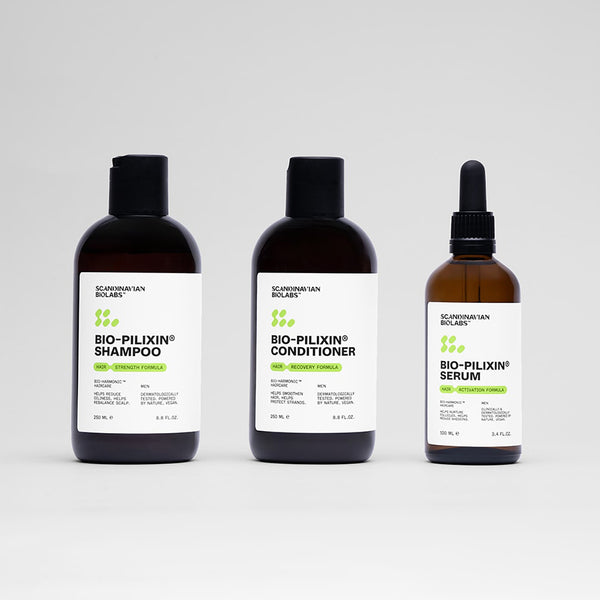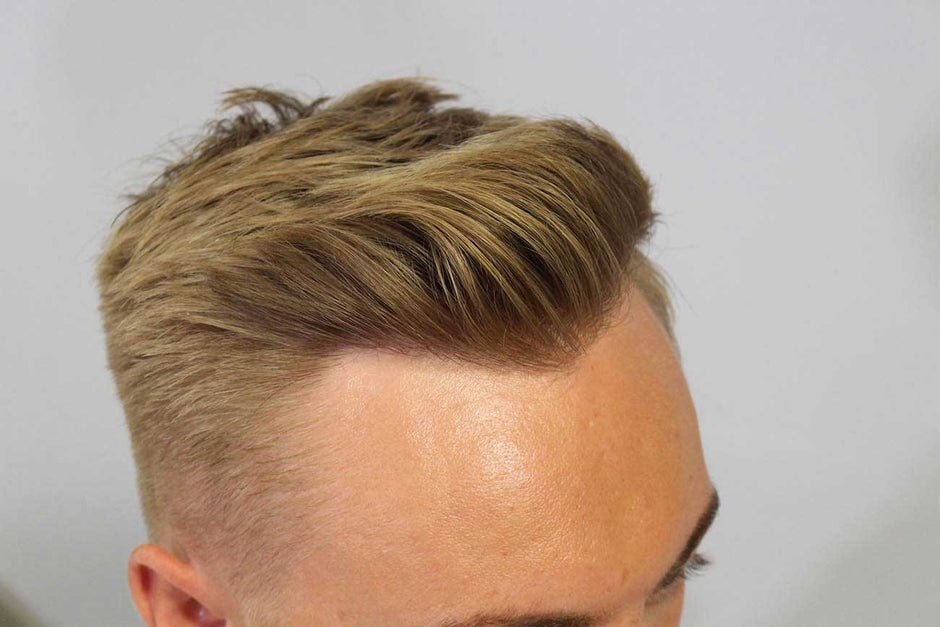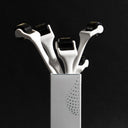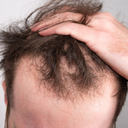Your hairline plays a bigger role in your overall look than you might realise. From defining your face shape to influencing which hairstyles suit you best, understanding your hairline can help you make smarter grooming and styling choices.
There are several different hairline types. Each with its own unique characteristics and style advantages.
We've created a comprehensive resource to help you understand hairline types, their characteristics, and how to enhance them.
Hairlines can vary in height, shape, and symmetry, influenced by genetics, age, and hair care habits.
Table of content
Key Takeaways
- The 9 hairline types—straight, rounded, widow's peak, receding, uneven, cowlick, M-shaped, high, and low—vary in shape and height, influencing hairstyle choices and facial aesthetics.
- Genetics and hormones, especially DHT, primarily determine hairline shape, with men more prone to recession due to male pattern baldness (affecting 85% by age 50).
- Women typically have stable, softer hairlines (e.g., rounded or bell-shaped), but hormonal changes or traction alopecia can cause thinning or recession.
- Styling techniques, like textured cuts for receding hairlines or fringes for high hairlines, can enhance or conceal specific hairline features.
- Maintaining hairline health involves gentle hair care, a nutrient-rich diet (protein, iron, biotin), and treatments like minoxidil or scalp massage to boost circulation.
- Early professional consultation for rapid hairline changes ensures timely intervention, with treatments like minoxidil or hair transplants showing results in 3–18 months.

As your leading source for hair health information over the past 4 years, we never compromise on accuracy. When it comes to your health, you deserve information you can truly rely on - and earning your trust is our top priority.
Here's how Scandinavian Biolabs ensures every piece of content meets the highest standards of accuracy and integrity:
- Credentialed Experts: Our reviewers are actively practicing doctors and medical researchers
- Stringent Reviews: Content undergoes rigorous editing by subject specialists and review by a practicing doctor.
- Evidence-Based: We rely on well-established research from trusted scientific sources like peer-reviewed journals and health authorities.
- Full Transparency: Our editorial standards, writer credentials, reviewer credentials, correction process, and funding are all publicly documented.
- Independent Voice: While we do promote products, we operate in a vacuum to business operations. Our main goal is just an unwavering commitment to providing medically-sound guidance.
You can count on Scandinavian Biolabs to consistently deliver the trustworthy health information you deserve. Read our Editorial Standards.
What is a hairline and why does it matter?
Your hairline is the edge where your hair meets your forehead, running from temple to temple. The frontal hairline refers specifically to the hairline at the front of the scalp, which plays a key role in facial aesthetics.
This natural border significantly impacts your facial proportions and overall appearance.
A hairline is the boundary between your hair and forehead that frames your face. It's determined by genetics, hormones, age, and lifestyle factors. A mature hairline typically shifts slightly higher during early adulthood, usually by about half an inch to an inch. Male pattern baldness affects around 80% of men by age 80.
The science behind hairlines
Your hairline shape and position are primarily determined by:
- Genetic factors - inherited from parents
- Hormonal influences - particularly DHT (dihydrotestosterone). These factors impact the health and density of hair follicles at the hairline, which in turn affects the shape and position of your hairline.
- Age-related changes - most noticeable after age 25
- Lifestyle factors - stress, nutrition, hair care practices
Why does hairline type matter?
Understanding your hairline type helps you:
- Choose flattering hairstyles that complement your face shape and type of hairline
- Identify early signs of hair loss or changes
- Select appropriate hair care products and treatments
- Make informed decisions about styling techniques
What are the different types of hairlines?
There are 9 main hairline types that vary in shape, height, and pattern. These are the most common types found in men and women, and understanding common hairline types can help you identify your own.
The hairline types are: straight, rounded, widow's peak, receding, uneven, cowlick, M-shaped, high, and low hairlines.
Complete hairline type breakdown
1. Straight Hairline
Appearance: Forms a straight horizontal line across the forehead; the hair begins at an even level, creating a straight lined hairline. This type is often associated with a youthful, healthy look and is common in young adults and those with thick hair. The straight lined hairline is frequently considered the normal hairline or standard type due to its symmetry and balanced appearance.
Common in: Young adults and those with thick hair
Styling advantage: Works well with most hairstyles
Considerations: May appear harsh on some face shapes
2. Rounded Hairline
Appearance: Gentle curve following the forehead's natural shape; the hair begins in a soft arc, forming a round hairline. This round hairline differs from M-shaped or U-shaped types by its smooth, curved outline.
Common in: Women and men with fuller hair
Styling advantage: Softens facial features
Considerations: Creates a youthful appearance
3. Widow’s Peak Hairline
Appearance: Distinctive V-shaped point in the centre; the hair begins with more hair at the centre of the forehead, forming a widow's peak hairline. This V-shaped or upswept feature is a hereditary trait and stands out from other hairline types.
Common in: 25–30% of the population (depending on ethnicity and gender)
Styling advantage: Adds character and definition
Considerations: Can be emphasised or minimised with styling
4. Receding Hairline
Appearance: Hair retreats from temples, creating higher forehead; the hair begins further back on the scalp.
Common in: Men over 25 (affects 85% by age 50)
Styling advantage: Can look distinguished when well-maintained
Considerations: May indicate male pattern baldness
5.Uneven or Triangular Hairline
Appearance: Asymmetrical, with one side higher than the other, or a triangular hairline where the hair begins with a peak near the centre and slopes down towards the temples. The triangular hairline is a distinctive shape, often associated with certain hair loss patterns or natural variation.
Common in: Natural variation or result of hair damage
Styling advantage: Can be balanced with strategic cutting
Considerations: May need professional styling advice
6. Cowlick Hairline
Appearance: Hair grows in multiple directions, creating irregular patterns; the hair begins in swirling or unpredictable ways.
Common in: Those with natural cowlicks at the crown
Styling advantage: Adds texture and movement
Considerations: Requires specific styling techniques
7. M-Shaped Hairline
Appearance: Forms an "M" pattern with receding temples; the hair begins in an M shape, with the centre lower and the sides receding.
Common in: Men experiencing early pattern baldness
Styling advantage: Can create mature, sophisticated look
Considerations: Often precedes further hair loss
8. High Hairline
Appearance: Starts well above the eyebrows, creating a large forehead; the hair begins higher up on the scalp. A high hairline begins further up the scalp and may make a person's forehead appear larger.
Common in: Genetic trait or result of hair loss
Styling advantage: Creates elegant, intellectual appearance
Considerations: May benefit from fringe or layered styles
9. Low Hairline
Appearance: Begins close to the eyebrows; the hair begins at a lower point, resulting in a smaller distance between the hairline and eyebrows, which creates a smaller forehead.
Common in: Children and some adults (genetic)
Styling advantage: Creates youthful appearance
Considerations: Limited styling options for updos
How do hairline types differ between men and women?
Men experience more dramatic hairline changes throughout life, whilst women typically maintain stable hairlines with unique shapes and patterns. This difference is primarily due to hormonal factors and genetic predisposition to pattern baldness.
Women's hairlines, or women's hairlines, tend to remain stable but can vary in shape and position, and understanding these variations can help inform hairstyle choices.
Men are more likely to develop receding, M-shaped, or high hairlines due to male pattern baldness. Most men experience some degree of hairline recession by age 50. Women typically have stable straight, rounded, or low hairlines throughout life.
Male hairline patterns
Common progression in men
- Juvenile hairline (teens): Low, straight across forehead. A juvenile hairline is characterised by a low, rounded appearance commonly seen in children and teenagers.
- Mature hairline (20s-30s): Slight recession at temples, often representing the early stages of hairline recession
- Receding patterns (30s+): Progressive temple recession, which may begin in the early stages of male pattern baldness
- Advanced patterns (40s+): Significant recession or balding
Male-specific considerations:
- 85% of men experience some hairline recession by age 50
- DHT sensitivity causes follicle miniaturization
- Pattern typically follows Norwood scale classification
- Earlier intervention yields better treatment results
Typical Female Hairline Types
- Straight hairlines - most common, creates clean look
- Rounded hairlines - softer, more feminine appearance
- Bell-shaped - considered ideal, symmetrical and balanced
- Widow's peak - genetic trait, can be very flattering
Thinning hair or a thinner hairline can occur, especially with age or hormonal changes, and may affect the overall appearance.
Female-specific factors:
- Hormonal changes during menopause may affect hairline and can lead to a thinner or thinning hairline in women
- Pregnancy can temporarily alter hairline position
- Styling damage (tight ponytails) can cause traction alopecia
- Female pattern hair loss affects crown more than hairline
For styling, options like soft fringes can help conceal or enhance certain hairline types, especially if thinning hair is a concern.
What causes different hairline shapes and changes?
Hairline shape and changes are primarily determined by genetics, hormones, and environmental factors. Understanding these causes helps in prevention and treatment planning.
Genetics determine your natural hairline shape, whilst hormones (especially DHT) cause changes over time. Ageing also naturally affects hairline characteristics, often leading to recession or thinning. Other factors, such as environmental stress and health conditions, can also influence hairline changes.
Certain health conditions, including hormonal imbalances, may lead to hairline recession or thinning. Lifestyle factors like stress, nutrition, and hair care practices can accelerate or slow these changes.Concerned about early hairline changes? Try the Bio-Pilixin Serum – clinically shown to reduce hair loss by 77% in 45 days.
Genetic factors
- Family history - look at parents and grandparents
- Ethnic background - certain patterns more common in specific groups
- Gender - X-chromosome carries hair loss genes
- Age of onset - early changes often indicate genetic predisposition
Hormonal influences
- Dihydrotestosterone (DHT) - primary cause of male pattern baldness
- Oestrogen - protective hormone that maintains hair growth
- Thyroid hormones - affect overall hair health and growth
- Stress hormones - cortisol can accelerate hair loss
Environmental and lifestyle factors
- Nutrition - protein, iron, and vitamin deficiencies affect hair health
- Stress levels - chronic stress accelerates hair loss
- Hair care practices - excessive heat, chemicals, tight styling
- Medical conditions - autoimmune disorders, medications, and certain treatments such as chemotherapy can result in permanent hair loss
How can you determine your hairline type?
To identify your hairline type, examine your hairline in natural light using a mirror, noting its shape, height, and any asymmetries. Identifying whether you have a good hairline can help you choose the most flattering styles and address any concerns early. Take photos from multiple angles for accurate assessment.
Stand in natural light, pull hair back completely, and examine the shape where your hair meets your forehead. Note the height, symmetry, and overall pattern.
Step-by-step identification process
-
1
Preparation
- Use natural lighting (near a window)
- Pull all hair away from face
- Have a handheld mirror for side views
- Take photos for objective analysis
-
2
Shape assessment
- Straight line – runs horizontally across forehead
- Curved pattern – follows natural forehead curve
- V-shape – point in centre (widow's peak)
- M-pattern – receded at temples
- Irregular – uneven or multiple patterns
-
3
Height measurement
Measure from eyebrow to hairline centre:
Low · 2–4 cm (0.8–1.6 inches) Medium · 4–6 cm (1.6–2.4 inches) High · 6+ cm (2.4+ inches) -
4
Symmetry evaluation
- Compare left and right sides
- Note any significant differences
- Check for natural variations vs. damage
Professional assessment benefits
Dermatologist can identify early hair loss signs
Trichologist specialises in hair and scalp conditions
Hair stylist provides styling recommendations
Professional photography shows subtle changes
What are the best hairstyles for each hairline type?
Choosing the right hairstyle for your hairline type can enhance your facial features and minimise any concerns. The right style can enhance your hairline type and overall appearance. Each hairline type has optimal styling approaches that work with, rather than against, its natural characteristics.
Straight hairlines suit most styles, widow's peaks look great with centre parts, receding hairlines benefit from textured cuts, and high hairlines pair well with fringes or shorter styles.
For some hairline types, longer hair can be used to conceal or highlight specific features, depending on your preferred look. Protective hairstyles are also a great option for maintaining hairline health, especially for those prone to traction alopecia.Styling guide by hairline type
Straight Hairline Styles
Best options: Blunt cuts, geometric styles, sleek looks
Avoid: Overly textured cuts that disrupt the clean line
Styling tips: Use smoothing products for enhanced straightness
Rounded Hairline Styles
Best options: Soft layers, side-swept fringes, natural textures
Avoid: Harsh geometric cuts that fight the curve
Styling tips: Enhance natural movement with light-hold products
Widow's Peak Styles
Best options: Centre parts, slicked-back looks, dramatic side parts
Avoid: Straight-across fringes that hide the peak
Styling tips: Use the peak as a natural styling guide
Receding Hairline Styles
Best options: Textured cuts, forward styling, strategic length
Avoid: Slicked-back styles that expose recession
Styling tips: Create volume and texture in front sections
High Hairline Styles
Best options: Fringes, layered cuts, shorter overall length
Avoid: Styles that expose the entire forehead
Styling tips: Use fringes or forward-styled hair strategically
Low Hairline Styles
Best options: Updos, slicked-back looks, shorter cuts
Avoid: Heavy fringes that overwhelm the face
Styling tips: Embrace the natural frame it provides
Universal styling principles
- Work with your natural hairline rather than against it
- Consider your face shape alongside hairline type
- Adjust length and layers to balance proportions
- Use styling products to enhance, not fight, natural patterns
- Choose totally natural hair care products and methods to support healthy hairline maintenance

How can you protect and maintain your hairline health?
Maintaining hairline health requires a combination of gentle hair care, proper nutrition, stress management, and protective styling practices. Prevention is always more effective than treatment. Early intervention can help slow the rate at which the hairline recedes. Regular scalp massage can boost hair growth and stimulate blood flow to the hair follicles.
Protect your hairline with gentle brushing, avoid tight hairstyles, use DHT-blocking ingredients, maintain good nutrition, and address hair loss early with proven treatments. Using anti-hairfall shampoos and conditioners can prevent substantial hair loss.
Daily hairline protection routine
Gentle handling practices
- Brush carefully - start from ends, work upward
- Avoid tight styles - no tension on hairline
- Sleep protection - silk pillowcases reduce friction
- Chemical caution - limit harsh treatments near hairline
- Avoid combing or brushing wet hair, as it can cause damage and breakage
Essential nutrients for strong hairlines:
- Protein - building blocks for hair structure
- Iron - prevents anaemia-related hair loss
- Vitamin D - supports follicle health
- Biotin - strengthens hair shaft
- Omega-3 fatty acids - reduce inflammation
- Vitamins B and C, along with zinc - important for maintaining hair health
Proven treatments for hairline maintenance

A comprehensive system designed to:
- Stop hair loss progression
- Stimulate new growth
- Strengthen existing hair
- Improve overall scalp health
Key ingredients:
- Capilia Longa® – Reduces hair loss and boosts density
- Niacinamide – Enhances hair strength via keratin production
- Aloe Vera – Soothes scalp and reduces dryness
- Amino Acid Complex – Increases hair strength and durability
- Vanillyl Butyl Ether – Stimulates scalp circulation
- Zinc PCA – Regulates scalp oil production
| Pros | Considerations |
|---|---|
|
|
Professional treatment options
- Low-level laser therapy - stimulates cellular activity
- Microneedling - improves product absorption
- PRP treatments - uses your own growth factors
- Prescription medications - Minoxidil, Finasteride
Natural maintenance methods
- Scalp massage - improves blood circulation
- Essential oils - rosemary, peppermint for stimulation
- Stress reduction - meditation, exercise, adequate sleep
- Regular trimming - prevents damage from spreading
When should you seek professional help for hairline concerns?
Consult a professional if you notice sudden hairline changes, significant thinning, or if hair loss impacts your confidence. If you notice your hairline beginning to recede, it may be time to consult a professional. Early intervention provides the best treatment outcomes. Seeking consultation with specialists can help individuals find appropriate restoration methods for their hairline.
See a dermatologist or trichologist if you experience rapid hairline recession, sudden hair loss, scalp irritation, or significant changes in hair texture within 3-6 months.
Red flag symptoms requiring immediate attention
- Rapid hairline recession - noticeable changes within months
- Patchy hair loss - circular or irregular bald spots
- Scalp inflammation - redness, itching, scaling
- Sudden texture changes - hair becomes brittle or thin
- Excessive shedding - more than 100 hairs daily
Types of hair loss professionals
In the UK, you can access hair loss specialists through:
- Your GP for NHS referrals to dermatology
- Private trichology clinics in major cities like London, Manchester, and Birmingham
- Specialist hair restoration clinics such as those accredited by the Care Quality Commission (CQC)
Dermatologist
Medical doctor specialising in skin and hair conditions. Can diagnose underlying medical causes and prescribes medications and medical treatments.
Best for: Sudden hair loss, scalp conditions, medical evaluation
Trichologist
Specialist in hair and scalp health. Provides detailed hair analysis and offers personalised treatment plans.
Best for: Gradual hair loss, product recommendations, lifestyle advice
Hair transplant surgeon
Surgical specialist in hair restoration. Performs FUE, FUT procedures and reconstructs hairlines permanently.
Best for: Advanced hair loss, cosmetic enhancement
Treatment timeline expectations
- Topical treatments - results in 3-6 months
- Oral medications - improvement in 6-12 months
- Laser therapy - gradual improvement over 6+ months
- Hair transplant - full results in 12-18 months
FAQs
What is the most attractive hairline type?
The most attractive hairline is typically proportional to your face shape. For women, a middle hairline 5-6 cm above the eyebrows is often considered ideal. For men, a slightly higher hairline 6-8 cm above the eyebrows is preferred.
Can you change your natural hairline type?
Yes, hairlines can be modified through various methods including hair transplants (permanent), laser hair removal (for lowering), styling techniques (temporary), and medical treatments for hair loss.
Is a receding hairline always a sign of baldness?
Not necessarily. Some hairline recession is normal as men mature from juvenile to adult hairlines. However, progressive recession, especially with crown thinning, may indicate male pattern baldness.
How early can hairline changes begin?
Hairline changes can start as early as the late teens for men. The juvenile hairline typically begins maturing into an adult hairline between ages 18-25, with further changes possible throughout life.
Are widow's peaks attractive?
Widow's peaks can be very attractive and are considered a distinctive, elegant feature. Many celebrities have prominent widow's peaks that enhance their appearance. British celebrities like Jude Law and Zayn Malik have distinctive widow's peaks that have become part of their signature looks.
Can women develop receding hairlines?
Yes, though less common than in men. Women can experience hairline recession due to hormonal changes, genetics, traction alopecia from tight hairstyles, or medical conditions.
How can I hide a receding hairline?
Options include strategic hairstyling (textured cuts, side parts), hair fibres or powders, hair systems, styling products for volume, and permanent solutions like hair transplant.
Do hair growth products work for hairlines?
Some do. Clinically proven ingredients like Minoxidil, Finasteride, and newer compounds like Capilia Longa can slow hair loss and potentially stimulate regrowth when used consistently.
Is it normal for hairlines to be asymmetrical?
Slight asymmetry is normal due to natural growth patterns and sleeping habits. Significant asymmetry may indicate damage, genetics, or early hair loss requiring professional evaluation.
How long does it take to see results from hairline treatments?
Most treatments require 3-6 months for initial results and 12+ months for full effects. Hair growth cycles are slow, so patience and consistency are essential for success.
Sources
- Hagenaars, S. P., Hill, W. D., Harris, S. E., Ritchie, S. J., Davies, G., Liewald, D. C., Gale, C. R., Porteous, D. J., Deary, I. J., & Marioni, R. E. (2017). Genetic prediction of male pattern baldness. PLoS Genetics, 13(2), e1006594. Read the study
- Kashiyama, K., Haraguchi, R., Ban, F., Yoshida, D., Fukuda, M., Date, N., … & Tanaka, K. (2021). Study of Frontal and Temporal Hairline Patterns in Japanese Subjects. Plastic and Reconstructive Surgery Global Open, 9(8), e3751. Read the study
- American Hair Loss Association. Men’s Hair Loss. americanhairloss.org. By age 35, two-thirds of American men have noticeable hair loss; by age 50, almost 85% experience significant thinning. Read the article
- Ustuner, E. T. (2013). Cause of Androgenic Alopecia: Crux of the Matter. Plastic and Reconstructive Surgery Global Open, 1(7), e64. Read the study
- American Academy of Dermatology (AAD). Hairstyles that pull can lead to hair loss. aad.org. Read the article






